Sport Fishing in Panama: A Guide to the Top Fish Species You Can Catch
Mahi Mahi (Coryphaena Hippurus)
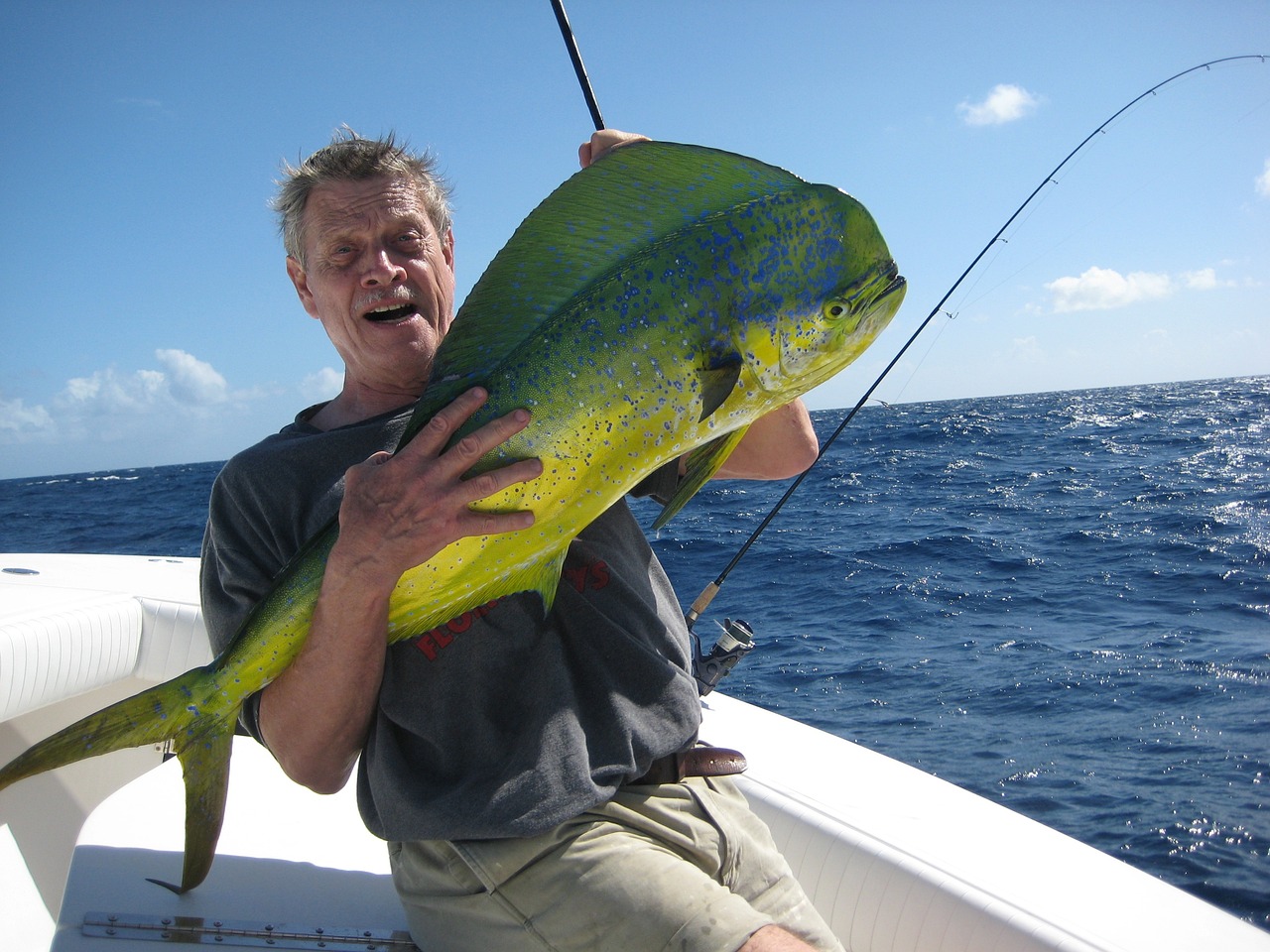
“Mahi Mahi Fishing in Panama: The Thrill of Catching the Elusive Dorado The Mahi Mahi, also renowned as Dorado, stands as a prized catch in the world of sport fishing. This article dives into the exhilarating experience of Mahi Mahi fishing in Panama, a paradise for anglers seeking the thrill of a fierce battle with this deep-sea marvel.
Season and Habitat In Panama, the Mahi Mahi thrives, particularly from April to November, aligning with the rainy months. This period marks the high season for Dorado fishing, offering anglers the best chance to land this prized fish. The Mahi Mahi’s habitat spans from the coastal waters to the deeper offshore realms of Panama. A notable hotspot for anglers is the ‘Twenty Fathom’ area, nestled between Isla Otoque and Taboga. This zone, named for its depth of 20 fathoms, is a magnet for Mahi Mahi, thanks to the abundant organic debris like branches, logs, and algae, which attract smaller species that serve as the primary prey for these fish.
Fishing Techniques and Gastronomy Anglers favor the Mahi Mahi for the intense battle it presents, making its capture a memorable experience. The fish’s ferocity and strength are matched by few, promising an adrenaline-packed adventure for fishing enthusiasts. Furthermore, Dorado is not just a trophy catch but also a culinary delight. Its meat is celebrated in gastronomy for its rich, intense flavor. It’s versatile in the kitchen, being a perfect fit for various preparations such as grilling, frying, or baking.
Conclusion Mahi Mahi fishing in Panama offers an unmatched experience for sport fishing aficionados. The combination of the challenging capture and the gastronomic value of the Dorado makes it a sought-after species in these waters. Whether you’re an experienced angler or a novice, the pursuit of Mahi Mahi in Panama is an adventure that promises both thrill and reward.”
Red Snapper (Lutjanus Campechanus)
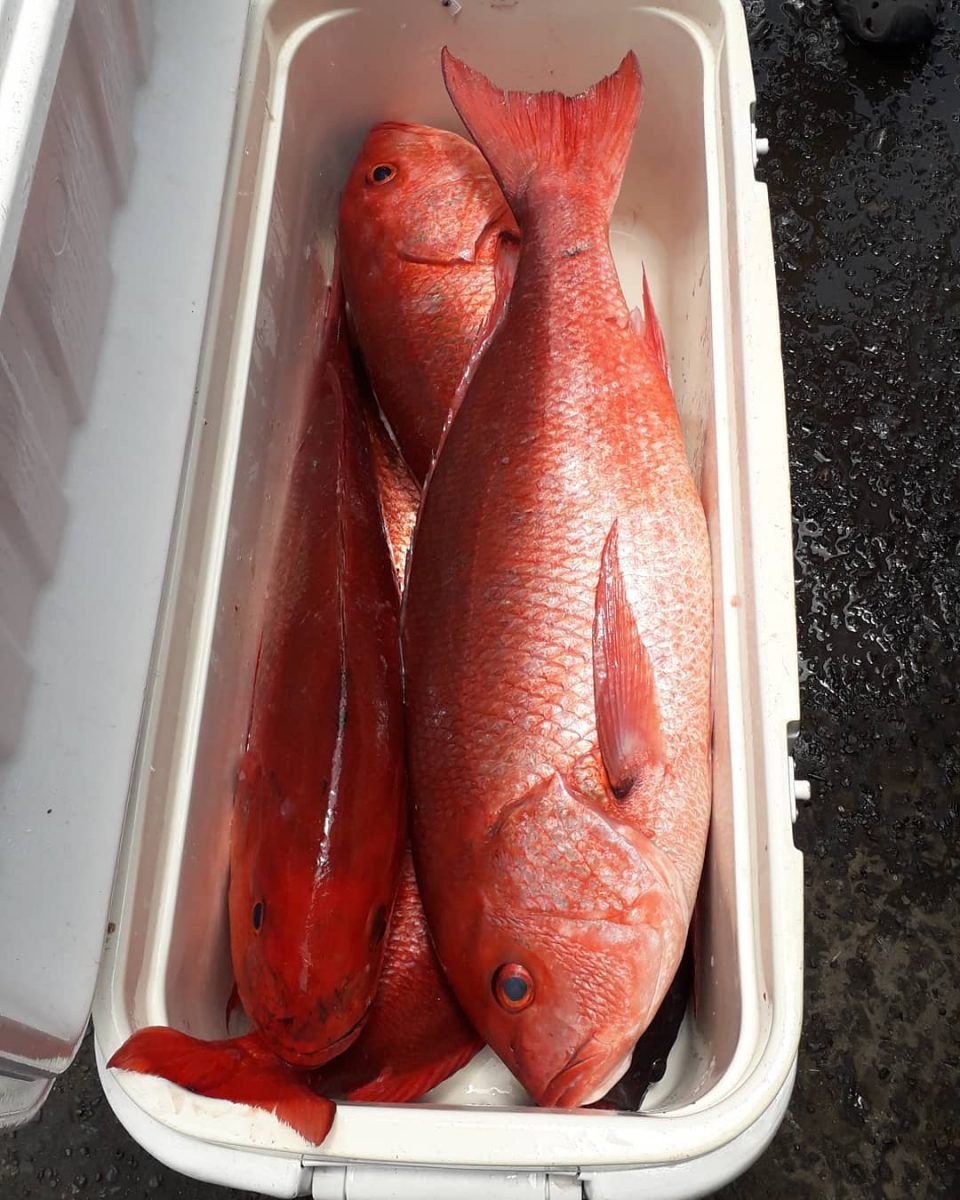
“Red Snapper Fishing in Panama: A Blend of Challenge and Flavor Panama, a haven for fishing enthusiasts, is renowned for its vibrant marine life and diverse coastal ecosystems. Among the treasured catches here is the Lutjanus Campechanus, commonly known as the Red Snapper, a top target for anglers due to its culinary value and the exciting challenge it presents.
Habitat and Fishing Techniques Thriving in the Pacific Ocean and the Caribbean Sea, the Red Snapper is a deep-sea dweller, typically found at depths of 20 to 50 meters, though it ventures into deeper waters as well. Its preferred habitats are coral reefs and rocky formations, offering abundant food sources and shelter.
Anglers employ various techniques to reel in this prized fish, including natural bait and artificial lure fishing. The choice of equipment is crucial, with fishing rods, reels, lines, and hooks all playing a part in a successful catch.
Regulations and Sustainable Practices Fishing for Red Snapper in Panama comes with a responsibility to adhere to local fishing regulations. Obtaining a fishing license and following set rules and restrictions are imperative for the conservation of fish populations and the promotion of sustainable fishing practices.
Handling a caught Red Snapper with care is essential to maintain the quality of its meat and ensure freshness. Many anglers use ice to preserve the fish during transport ashore.
Conclusion The pursuit of the Red Snapper in Panama offers a thrilling and rewarding experience for anglers. By employing appropriate techniques, using the right equipment, and respecting fishing regulations, fishermen can partake in sustainable angling, ensuring the preservation of this species for future generations. The Red Snapper is not just a catch but a culinary delight, making it a dual reward for those who respect and enjoy the rich offerings of Panama’s seas.”
Amberjack (Seriola Dumerili)
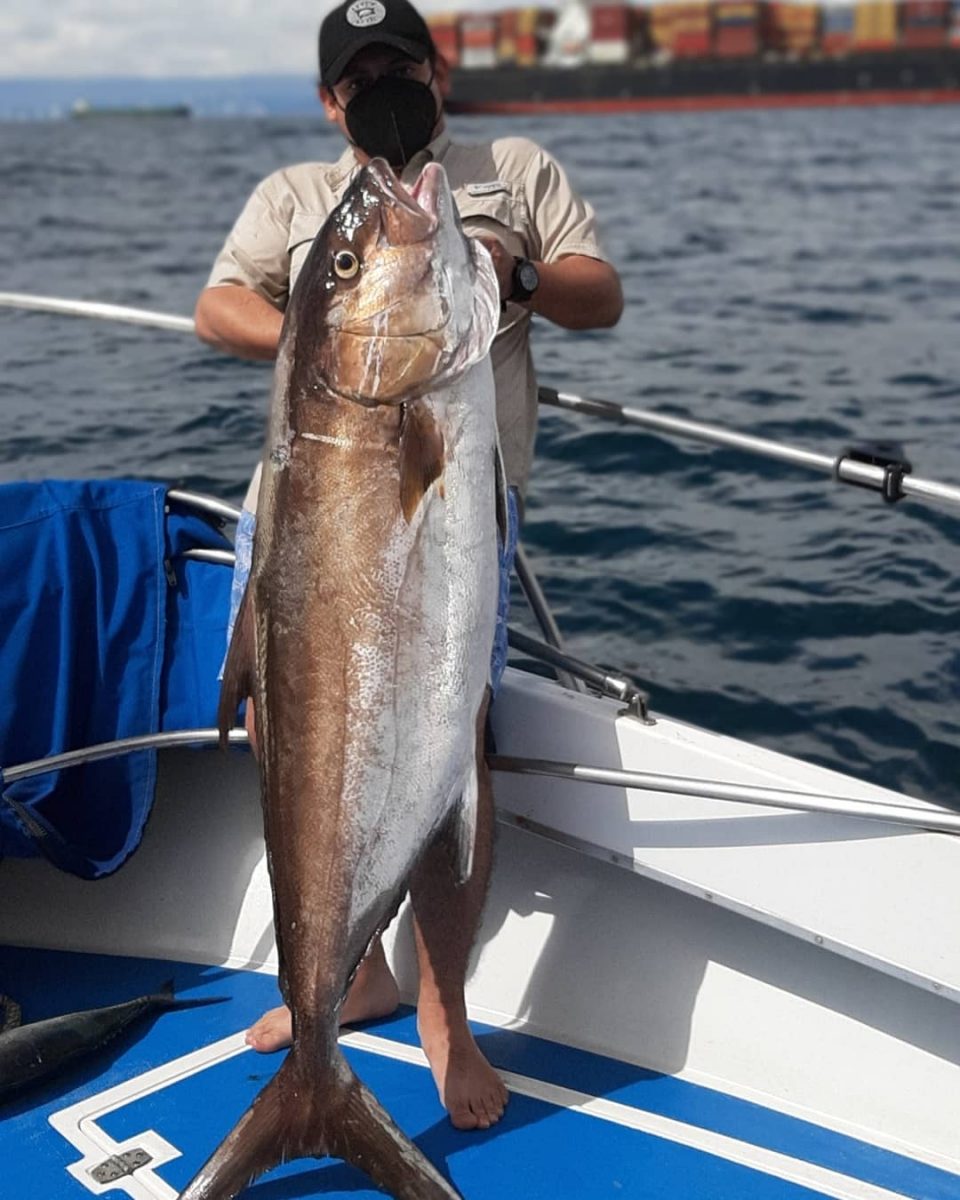
“Amberjack Fishing in Panama: Pursuing the Elusive Seriola Dumerili In the bountiful waters of Panama, the Amberjack, also known as Lemon Fish, reigns as a highly coveted catch among sport fishermen. This article delves into the world of Amberjack fishing in Panama, a destination revered for its rich marine life.
Habitat and Characteristics The Amberjack, thriving in the depths of the Pacific Ocean and the Caribbean Sea, is lauded for its impressive size, formidable strength, and swift speed. These traits make the Amberjack a challenging yet rewarding target for sport fishing enthusiasts.
Fishing Techniques and Equipment To capture the elusive Amberjack, anglers employ a variety of techniques and specialized equipment. While fishing rods, reels, lines, and artificial lures are standard, many prefer natural baits like squid and sardines to lure these large fish. The choice of bait and technique plays a crucial role in the success of Amberjack fishing.
Best Season and Time for Fishing Amberjack fishing in Panama reaches its peak excitement during the summer months. This period sees the Amberjack migrate to the warmer coastal waters, offering anglers ample opportunities. The optimal times for fishing are early morning or late afternoon when the Amberjack are most active.
Regulations and Sustainable Practices Fishing for Amberjack in Panama requires adherence to specific regulations. Anglers must obtain a fishing license and comply with the rules and restrictions established by local authorities. These measures are critical for ensuring sustainable fishing practices and preserving the Amberjack population.
Handling and Preservation Once caught, careful handling of the Amberjack is imperative to maintain the quality of its meat and ensure freshness. Many anglers use ice to preserve the fish during transportation to shore.
Conclusion Amberjack fishing in Panama presents an exhilarating challenge for sport fishermen. With the right techniques, equipment, and respect for fishing regulations, anglers can enjoy the thrill of capturing this majestic fish. The experience not only offers the excitement of the catch but also contributes to the sustainable practice of sport fishing in Panama’s rich marine ecosystem.”
This revised version of your article on Amberjack fishing in Panama is structured to improve search engine visibility while engaging readers with informative and captivating content.
Roosterfis (Nematistius Pectoralis)
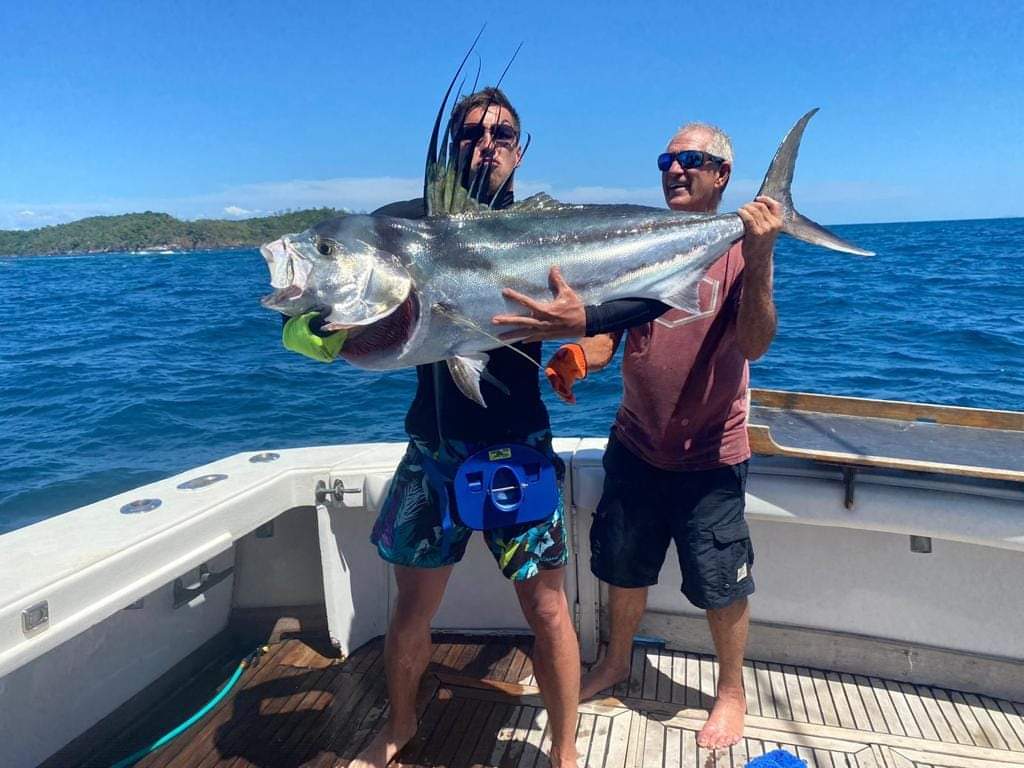
“Roosterfish Fishing in Panama: The Thrill of Capturing Nematistius Pectoralis In the sport fishing community, the Roosterfish, known scientifically as Nematistius Pectoralis, is celebrated for its unique appearance and challenging catch. This article delves into the exhilarating world of Roosterfish fishing in Panama, a destination renowned for its rich marine biodiversity.
Distinct Features and Habitat The Roosterfish, recognizable by its striking fan-shaped dorsal fin, is a native species to the Pacific Ocean. Known for its proclivity to hunt in the breakers near the coast, this fish is a favorite amongst sport fishermen for its strength and speed during the catch.
Popularity Among Sport Fishermen In Panama, the Roosterfish is a prized catch for sport fishermen. The excitement of reeling in this powerful fish, coupled with its swift movements, makes for an unforgettable fishing experience. Anglers often opt for artificial lures and prefer shore-based fishing to enhance the authenticity of the experience.
Prime Location and Season The Gulf of Chiriquí, located along the Pacific coast of Panama, is a prime hotspot for Roosterfish fishing. Here, anglers can enjoy not only the pursuit of the Roosterfish but also the region’s stunning beaches and diverse marine life. The fishing season for Roosterfish in this area extends from November to April, with peak activity observed in January and February.
Regulations and Sustainable Practices To fish for Roosterfish in Panama, anglers are required to obtain a fishing license and adhere to the local fishing regulations. These rules are set in place to ensure sustainable fishing practices and to help preserve the Roosterfish population for future generations.
Conclusion Roosterfish fishing in Panama offers a thrilling and memorable experience for sport fishermen. With the right approach and adherence to sustainable practices, anglers can enjoy the challenge of capturing this distinctive and fast fish, contributing to the conservation of the species and the enjoyment of Panama’s vibrant marine ecosystem.”
Wahoo (Acanthocybium Solandri)
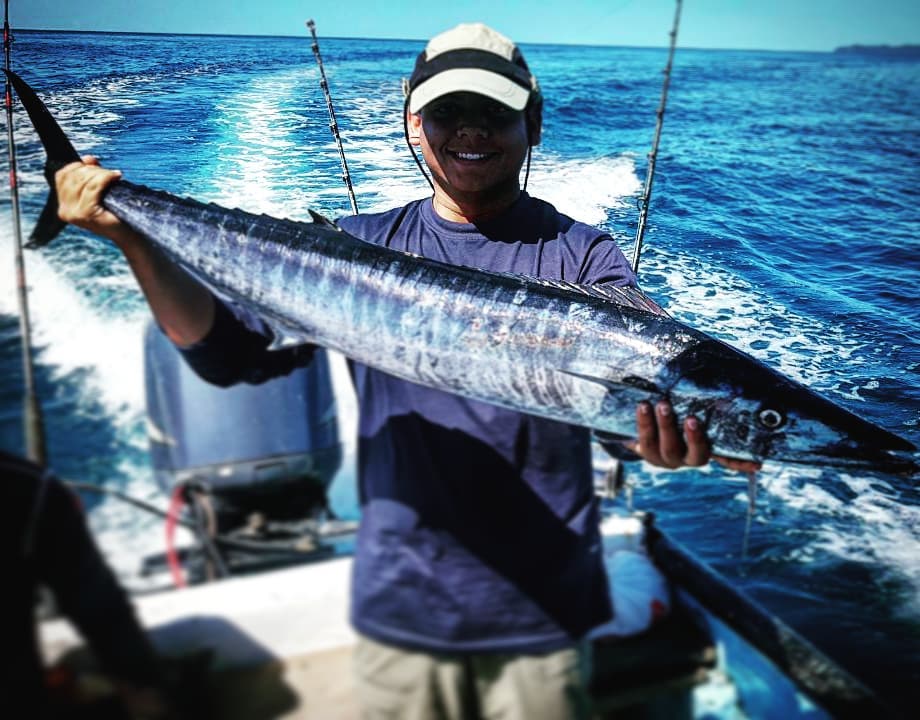
“Wahoo Fishing in Panama: The Thrill of Chasing Acanthocybium Solandri Renowned for its speed and strength, the Wahoo, or Acanthocybium Solandri, is a prized catch in the sport fishing world. This article explores the exhilarating pursuit of Wahoo fishing in Panama, a hotspot for this sought-after species found in the Atlantic, Pacific, and Indian oceans.
The Wahoo’s Appeal in Sport Fishing The Wahoo, known as Ono in some regions, is a top target for sport fishermen globally, including in Panama. Esteemed for its delectable flavor and the challenge it presents during the catch, the Wahoo is a desirable species for anglers. Found in the Pacific waters off Panama and its surrounding islands, these fish are known for their astonishing speed, capable of reaching up to 50 miles per hour, and their tendency to leap from the water to evade capture.
Best Season for Wahoo Fishing In Panama, the Wahoo fishing season spans from November to April, peaking in January and February. Anglers often employ topwater lures to attract Wahoos, targeting areas near reefs and underwater structures where these fish are commonly found.
Fishing Techniques and Culinary Delight Wahoo fishing presents a significant challenge, requiring preparedness for a vigorous fight. Sustainable fishing practices are encouraged, with anglers advised to release any fish not intended for consumption. Once caught, the Wahoo is celebrated in the culinary world for its firm white meat, versatile in preparation methods like grilling, roasting, or smoking. Wahoo ceviche is a popular dish in Panama’s seafood restaurants.
Conclusion Wahoo sport fishing in Panama offers a thrilling experience for anglers, combining the excitement of a challenging catch with the reward of a culinary delight. It’s crucial for fishermen to adhere to local fishing regulations and embrace sustainable practices, ensuring the preservation of the Wahoo population for future generations. The pursuit of the Wahoo in Panama’s waters is not just a sport but a sustainable endeavor, contributing to the ecological balance and offering a memorable adventure.”
Pacific Sierra (Scomberomorus Sierra)
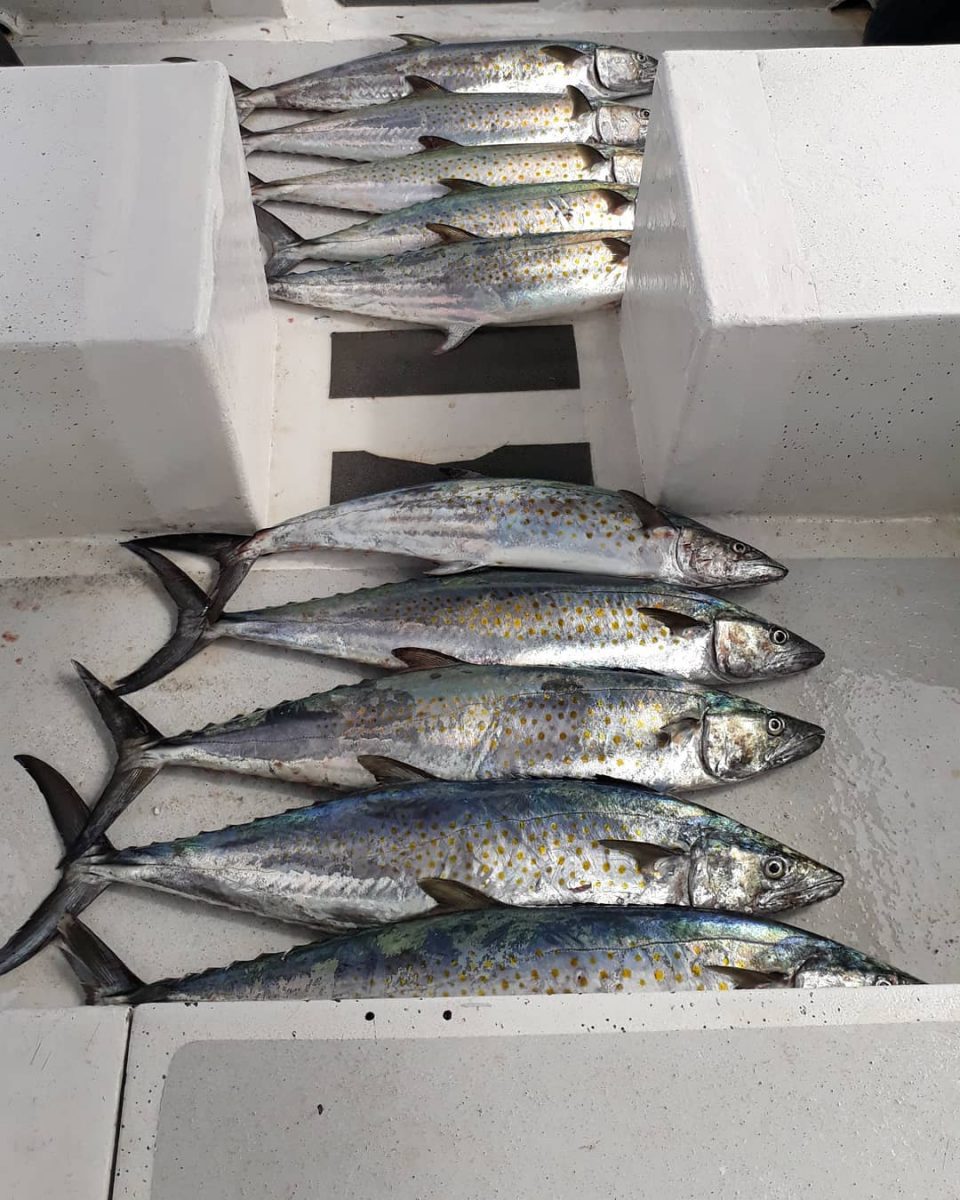
“Pacific Sierra Fishing in Panama: A Blend of Challenge and Culinary Delight The Pacific Sierra, also known as the Mexican Sierra, ranks high among sport fishermen in Panama. This article delves into the thrilling world of Pacific Sierra fishing, a species renowned for its agility and gastronomic appeal, found in the tropical and subtropical waters of the Pacific and Atlantic.
Habitat and Fishing Season Characterized by an elongated body, shimmering silver color, and sharp fins, the Pacific Sierra thrives in Panama’s waters. The prime fishing season extends from March to November, a period when larger specimens are typically found. These fish are often located in nearshore areas, where they feed on smaller fish, presenting an exciting opportunity for anglers.
Techniques for Capturing Pacific Sierra Anglers employ a variety of techniques to catch this coveted species. These include fishing with artificial lures, natural baits, and even fly fishing. Due to the Pacific Sierra’s strength and agility, the experience of catching one is both challenging and exhilarating.
Sustainable Fishing Practices Sustainable fishing practices are highly recommended for those targeting Pacific Sierra. Anglers are encouraged to release specimens they don’t plan to consume, helping to preserve the species for future generations.
Culinary Appreciation In the culinary realm, the Pacific Sierra is prized for its white, firm meat. Versatile in preparation, it can be enjoyed grilled, roasted, or in ceviche. Seafood restaurants across Panama often feature Pacific Sierra as a star ingredient in their dishes.
Conclusion Sport fishing for Pacific Sierra in Panama offers more than just the thrill of the catch; it’s a chance to engage with nature responsibly while anticipating a gourmet treat. Remembering to adhere to fishing regulations and sustainable practices ensures that this prized species remains abundant for future generations of anglers. Sport fishing in Panama’s coastal waters is not only a pursuit of a challenging catch but also a commitment to environmental stewardship.”
Garfish, Garpike or Sea Needle (Belone Belone)
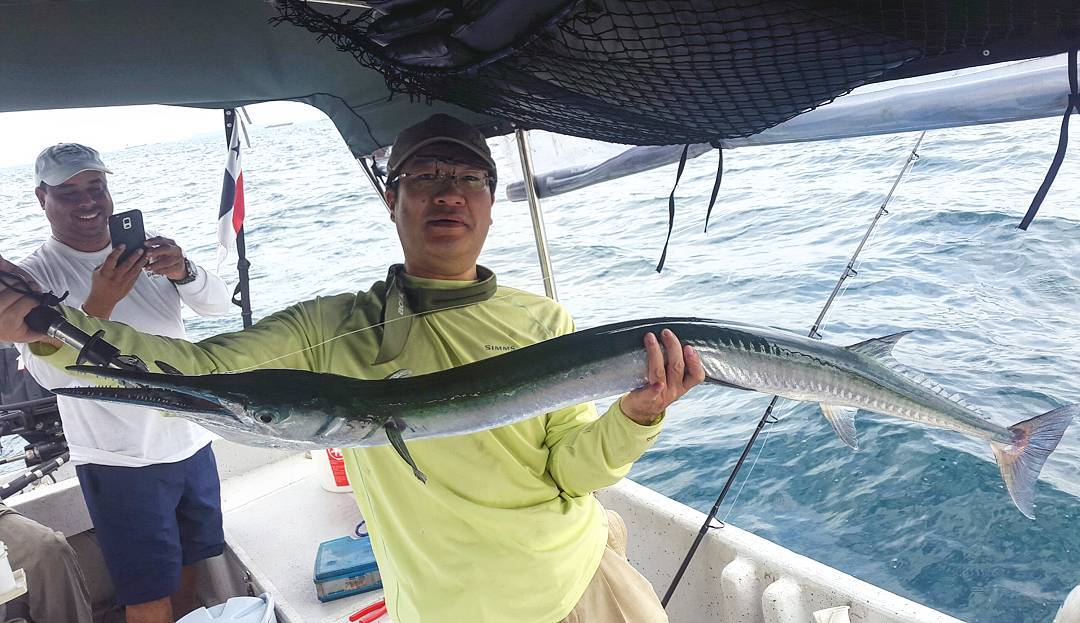
“Garfish Fishing in Panama: The Thrill of Catching the Agile Sea Needle In the coastal waters of Panama, the Garfish, also known as Belone Belone or Sea Needle, is a prized catch among sport fishermen. This article explores the exhilarating experience of Garfish fishing, highlighting the species’ strength and speed.
Characteristics and Habitat The Garfish, often mistaken for marlin due to its elongated, slender body, is an impressive species. Capable of growing over a meter in length, it’s known for its agility and speed, making it a desirable target for sport fishing enthusiasts.
Fishing Season and Techniques In Panama, the Garfish fishing season spans from December to May, peaking in January and February. Anglers typically search for this fish in shallow waters close to shore, where it’s known to frequent.
The most popular method for catching Garfish is using artificial lures. These brightly colored lures are effective in attracting the fish to the water’s surface, setting the stage for an exciting catch. The battle with a Garfish is intense and thrilling, marked by the fish’s agility and tendency to leap out of the water.
Sustainable Fishing Practices Sport fishermen are encouraged to practice sustainable fishing. This includes releasing specimens not intended for consumption, contributing to the conservation of the Garfish population and the overall health of Panama’s marine ecosystems.
Conclusion Fishing for Garfish in Panama offers an adrenaline-packed adventure for sport fishermen. With the right techniques and a commitment to sustainable practices, anglers can experience the joy of catching this swift and agile fish, while also playing a role in preserving the marine environment for future generations.”
Sea Bass (Argyrosomus Regius)
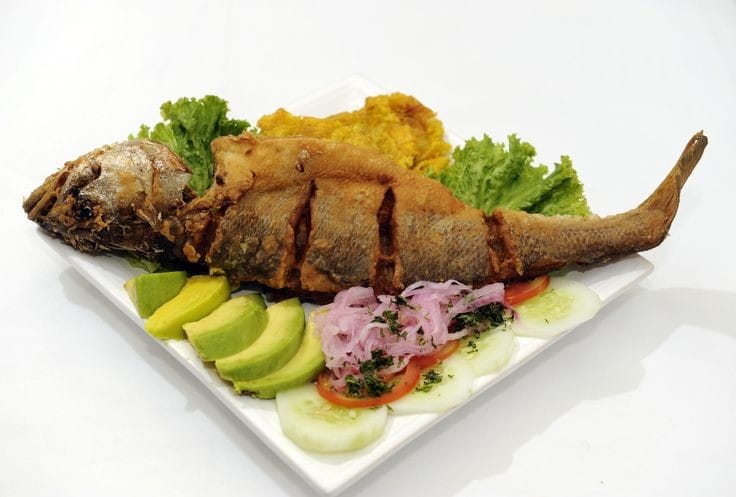
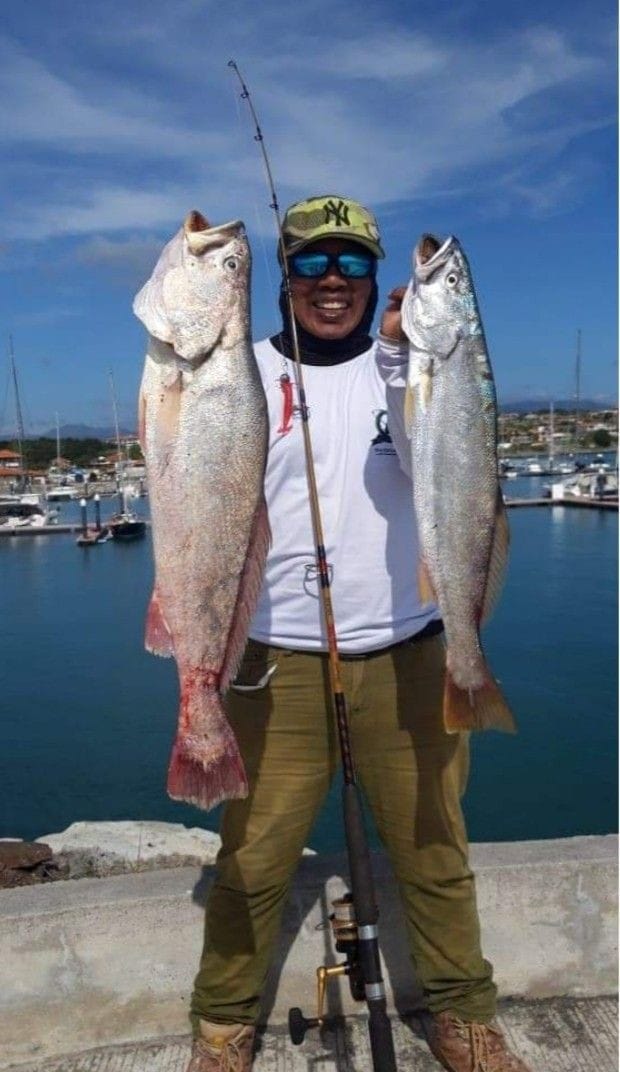
“Argyrosomus Regius Fishing in Panama:
Panama’s coastal waters are home to the Argyrosomus regius. Esteemed by sport fishermen for its impressive size and culinary delight, this fish is a prized catch in the region.
Fishing Season and Habitat
The Black Croaker’s fishing season in Panama typically extends from September to December, with the prime time for capture being in October and November. Found in deeper waters, this species preys on other fish and crustaceans, offering an intriguing challenge to anglers.
Techniques for a Successful Catch
To reel in an Argyrosomus regius, fishermen often opt for natural baits like squid, sardines, or shrimp. Live bait fishing has proven to be an effective technique for this species. Considering the potential weight of over 20 kg, it’s crucial to use a suitable hook size and robust fishing gear, including a strong line and a powerful reel.
The battle to catch a Black Croaker can be formidable, as this strong fish is known for swimming against the current. Handling it requires caution due to its powerful teeth, which can inflict serious injuries.
Culinary Appreciation
The meat of the Argyrosomus regius is revered in gastronomic circles for its high quality. Versatile in preparation, it can be grilled, fried, baked, or even used in regional specialties like ceviche, making it a sought-after ingredient in Panama’s seafood restaurants.
Yellowfin Tuna (Thunnus Albacares)
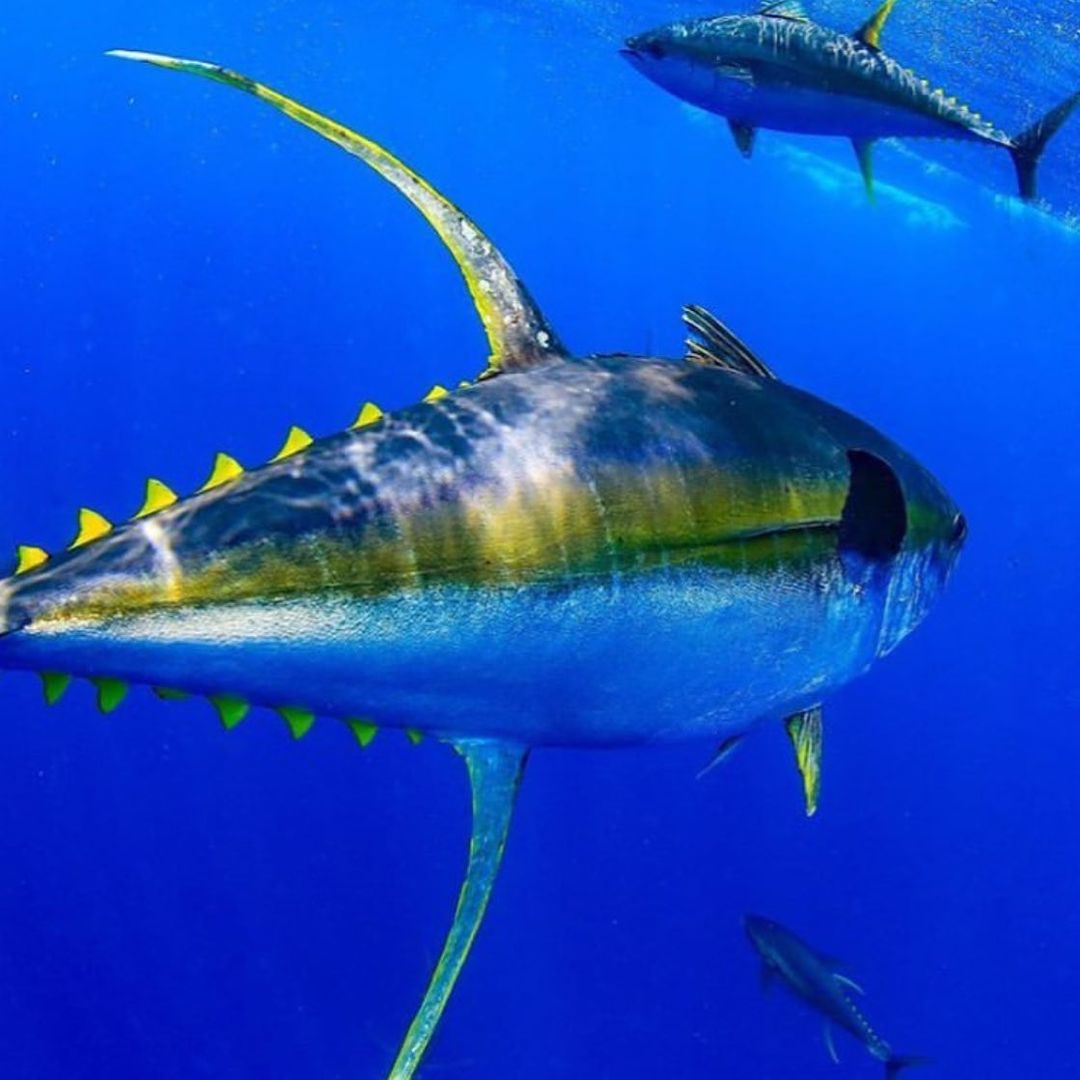
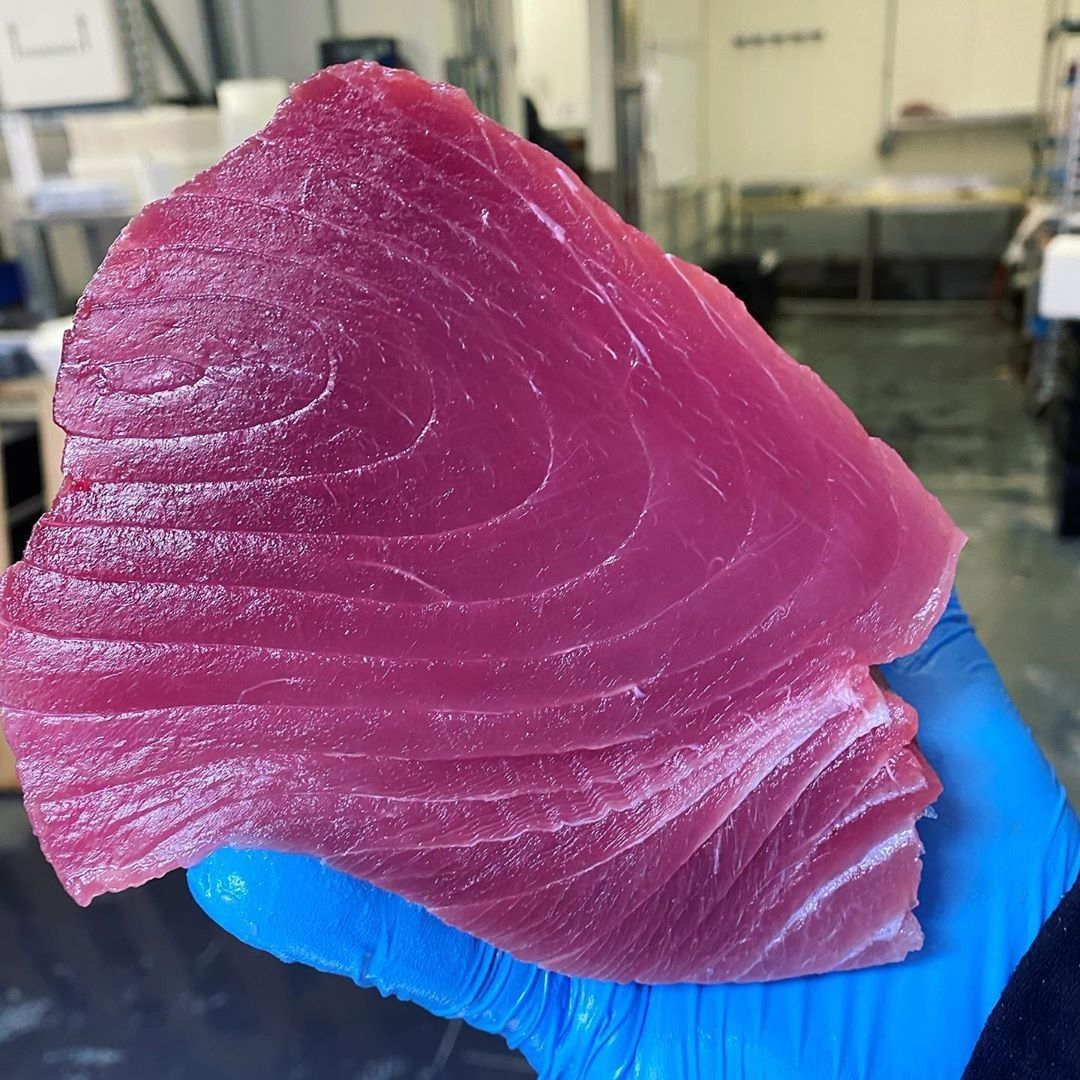
“Yellowfin Tuna Fishing in Panama: A Thrilling Quest for the Ocean’s Strong Fighters
Yellowfin Tuna, renowned for their impressive size and formidable fighting abilities, are among the top targets in sport fishing in Panama. This article explores the exhilarating world of Yellowfin Tuna fishing, a must-try for any avid sport fisherman.
Location and Best Season
Yellowfin Tuna are primarily found in the Pacific waters, with a significant presence off Panama’s coast. The optimal season for sport fishing these mighty fish is from May to September. During these warmer months, Yellowfin Tuna are more active, enhancing the fishing experience.
Advanced Fishing Techniques
Catching Yellowfin Tuna requires specialized equipment and advanced fishing techniques due to their strength and resilience. Essential gear includes heavy-duty fishing rods (50 to 80-pound class) and reels capable of holding at least 1,000 feet of line.
Chum fishing is a popular method in Panama for Yellowfin Tuna. This technique involves scattering small bait portions into the water to attract the fish. When the Tuna are close enough, anglers can try to catch them using either live or artificial bait.
Popper fishing is another effective approach. It involves using a surface lure, known as a popper, to mimic a small fish jumping on the water’s surface. The noise and movement of the popper attract Yellowfin Tuna, making for an exhilarating catch.
Sustainable Fishing Practices
Sustainable fishing practices are paramount when targeting Yellowfin Tuna in Panama. With the species’ numbers in decline globally, responsible fishing is essential. Panama’s fishing authorities have set regulations to limit daily catch amounts per person. Additionally, releasing fish not intended for consumption and employing sustainable fishing techniques are crucial to minimize impact on marine ecosystems.
Sailfish (Istiophorus)
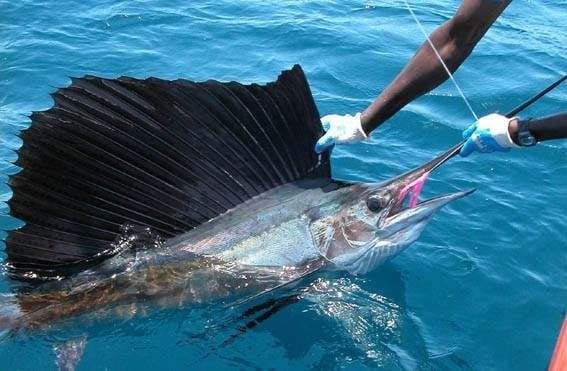
“Sailfish Fishing in Panama: An Exhilarating Adventure in the Pacific
In Panama, Sailfish are celebrated among sport fishermen for their remarkable strength and speed, offering a thrilling and challenging experience. This article delves into the exciting world of Sailfish fishing in Panama, a sought-after activity for fishing enthusiasts.
Location and Optimal Fishing Season
Sailfish thrive in the Pacific waters, particularly off Panama’s coast. The prime time for Sailfish sport fishing in Panama spans from May to Nov. During these warmer months, Sailfish are more active, making them easier to locate and catch.
Techniques for Successful Sailfish Fishing
Capturing Sailfish demands specialized equipment and advanced techniques, given their reputation for vigorous fighting and spectacular jumps. Essential gear includes heavy-duty fishing rods (80 – 120 pound class) and reels equipped with at least 1,000 feet of line.
One popular technique in Panama is fishing with artificial lures. This method involves casting lures that mimic small fish on the water’s surface to attract Sailfish. When a Sailfish approaches, anglers have the opportunity to catch it using either live or artificial bait.
Trolling is another effective approach for Sailfish fishing. In this method, a lure is towed at a constant speed to simulate a swimming small fish. The motion of the lure entices Sailfish, leading to an exhilarating catch.
Sustainable Fishing Practices and Regulations
Sustainable fishing practices are crucial when targeting Sailfish in Panama. With concerns about the declining numbers of Sailfish globally, responsible and sustainable fishing is essential. Anglers should be aware of and adhere to local fishing regulations to ensure the long-term preservation of the Sailfish population and the health of marine ecosystems.
Black Marlin (Istiompax Indica)
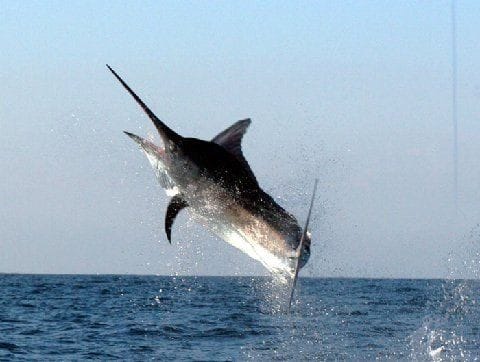
“Black Marlin Fishing in Panama: A Thrilling Pursuit for Sport Fishermen
The Black Marlin, known for its formidable size and strength, presents an exhilarating challenge to sport fishermen in Panama. This article dives into the experience of pursuing the majestic Black Marlin, a species that demands skill and persistence.
Ideal Location and Season
Black Marlins thrive in the Pacific waters, particularly off Panama’s coastline. The peak season for fishing these mighty fish is from June to September, a period when the waters warm up, encouraging more active fish behavior, thereby enhancing the fishing experience.
Specialized Fishing Techniques
To successfully catch a Black Marlin, anglers need specialized and advanced fishing techniques due to the fish’s incredible speed and power. Essential gear includes heavy-duty fishing rods (ranging from 80 to 130 pounds) and reels with a line capacity of at least 500 meters.
Live bait fishing is a popular method among anglers targeting Black Marlins in Panama. This technique involves using live bait, such as small fish or squid, to attract the marlin. When the Black Marlin approaches, a large and sturdy hook is essential for a successful catch.
Artificial lure fishing is another effective strategy. It entails using lures that mimic the movement of small fish on the water’s surface. This method can lure the Black Marlin close enough for an attempt at capture using a robust hook.
Sustainable Fishing Practices
Sustainable fishing is crucial when targeting Black Marlins in Panama. With the species’ population in decline globally, responsible fishing practices are essential.
Blue Marlin (Makaira Nigricans)
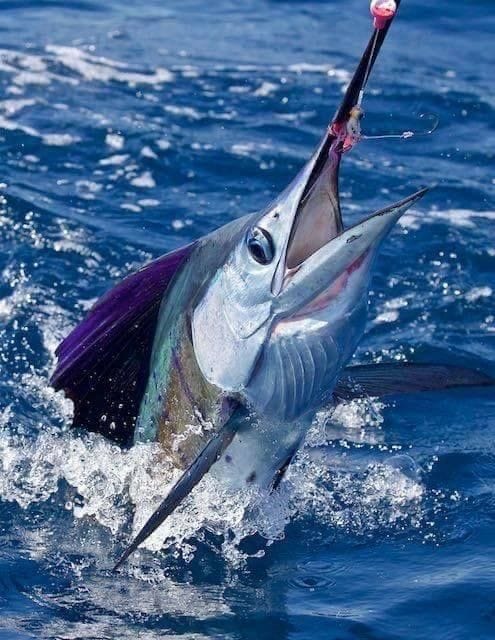
“Blue Marlin Fishing in Panama: The Ultimate Sport Fishing Adventure
Panama, a premier destination for sport fishermen, is home to the Blue Marlin, a species that stands out for its size, strength, and speed. This article takes a closer look at the thrilling experience of Blue Marlin fishing, a must-try adventure for serious anglers.
Prime Location and Season
The Blue Marlin, a gem of the Pacific waters, is commonly found off the coast of Panama. The optimal season for targeting this majestic fish is from May to Nov when the waters are warmer and the Blue Marlin are more active, increasing the chances of a successful catch.
Advanced Fishing Techniques and Equipment
Catching a Blue Marlin demands specialized equipment and advanced fishing techniques due to the fish’s exceptional power and speed. Anglers typically need heavy-duty fishing rods (80 to 130 pounds) and reels with a line capacity of at least 500 meters to handle the strength of these magnificent creatures.
Live bait fishing is a popular technique among Blue Marlin enthusiasts in Panama. This method involves using live bait like small fish or squid to lure the Marlin. When the fish approaches, it’s time to use a large and sturdy hook for a secure catch.
Artificial lure fishing is another effective approach. Anglers cast lures that mimic small fish swimming on the water’s surface. This technique can attract Blue Marlins, offering a chance to hook them with a robust hook.
Sustainable Fishing Practices
Sustainable fishing is crucial when pursuing Blue Marlin in Panama. With the species facing global decline, responsible fishing is vital.
African Pompano (Alectis Ciliaris)
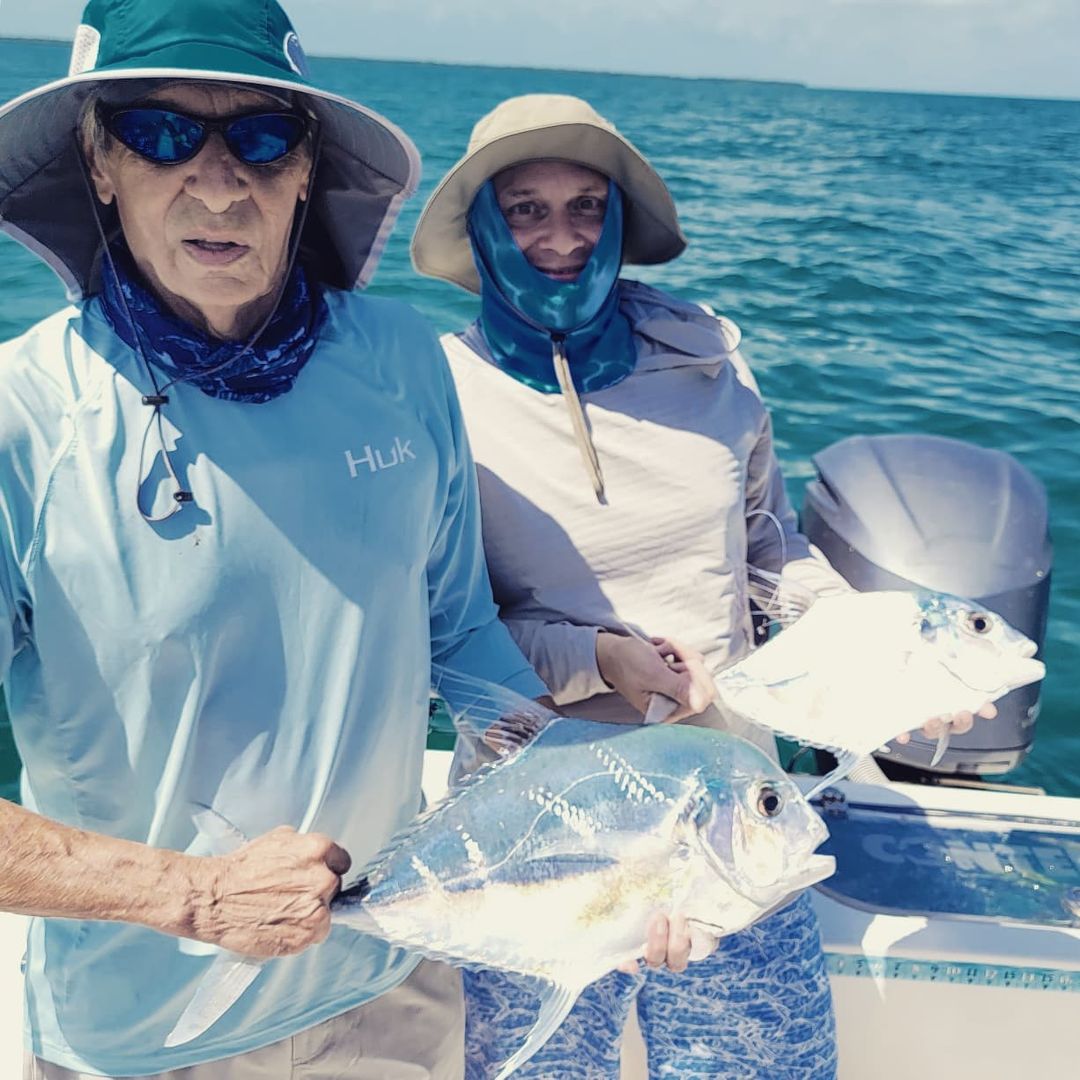
“African Pompano Fishing in Panama: A Blend of Excitement and Flavor
Among the variety of species coveted by sport fishermen in Panama, the African Pompano stands out for its exceptional fighting ability and excellent taste, offering an exhilarating and gratifying experience to anglers.
Prime Locations and Optimal Season
The African Pompano is prevalent in both the Pacific and Caribbean waters of Panama. This species is predominantly found in coastal regions and around coral reefs. The best time for sport fishing the African Pompano in Panama extends from May to September, a period when conditions are most favorable.
Diverse Fishing Techniques
Anglers can employ various techniques to catch the African Pompano, tailored to personal preferences and environmental conditions. A popular method involves using artificial lures, like jigs and spoons, known for their erratic movement in water, which effectively attracts this species.
Natural bait fishing is another widely used technique. Bait such as shrimp, squid, and small fish are excellent for luring the African Pompano. Bottom fishing, where the bait is placed at the sea’s bottom, is a common strategy, requiring patience as anglers wait for a bite.
Sustainable Fishing Practices
Sustainable fishing is essential for protecting the African Pompano and Panama’s marine ecosystems. The local fishing authorities have set regulations to limit daily catches per angler.
Cubera Snapper (Lutjanus Cyanopterus)
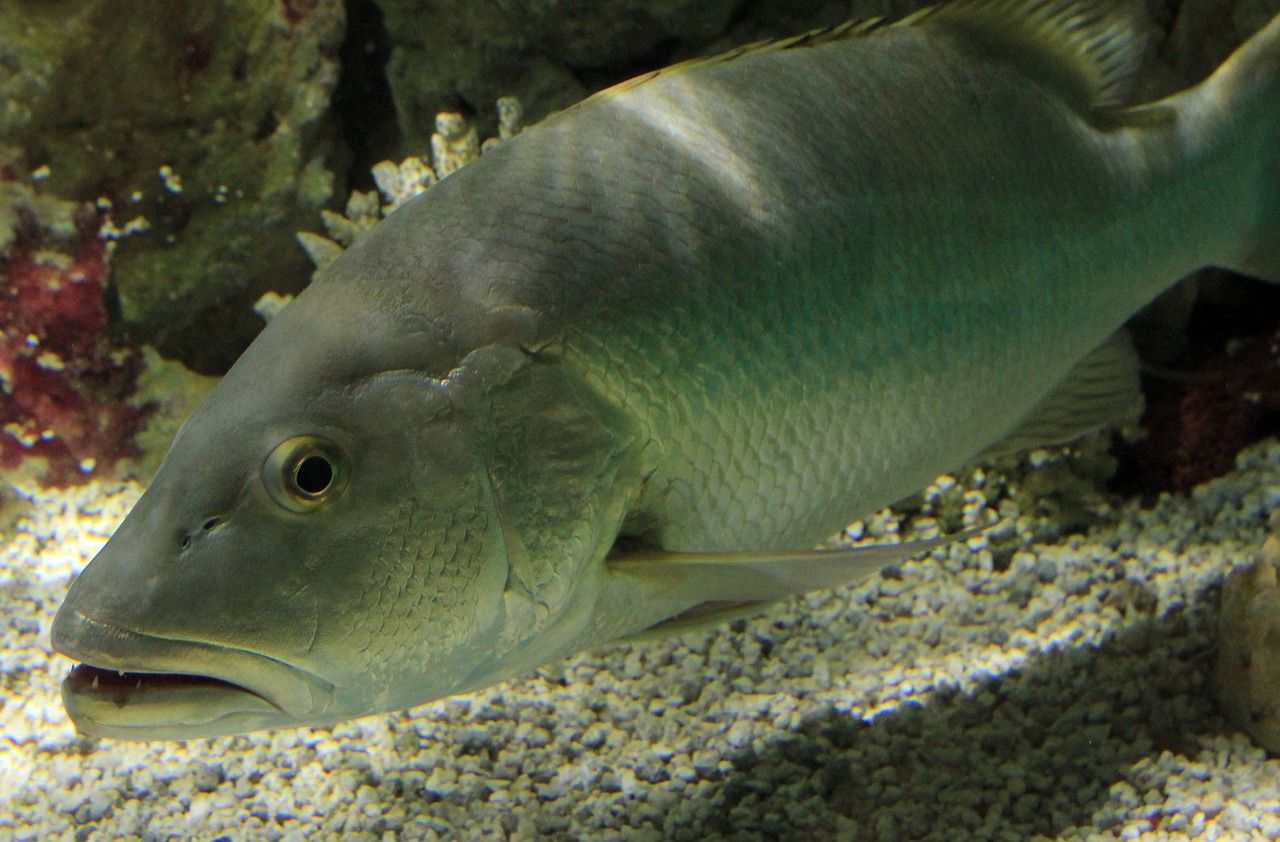
“Cubera Snapper Fishing in Panama: A Premier Sport Fishing Experience
Renowned for its size, strength, and rich flavor, the Cubera Snapper ranks as a top target for sport fishermen in Panama. This article delves into the exciting world of Cubera Snapper fishing, offering a detailed guide for anglers seeking this coveted catch.
Location and Optimal Fishing Season The Cubera Snapper, thriving in both the Pacific and Caribbean waters of Panama, is predominantly found in coastal areas and around coral reefs. The best season for fishing Cubera Snapper is from June to November, coinciding with more favorable sea conditions and increased chances of a successful catch.
Effective Fishing Techniques Catching the elusive Cubera Snapper demands skill, technique, and patience, making it a rewarding challenge for sport fishermen. One of the most effective methods is using live bait, such as crabs or shrimp, to entice this intelligent species.
Alternatively, anglers can use artificial lures like jigs and spoons. The key is to replicate the movements of the Snapper’s natural prey to attract them. Bottom fishing, where bait or lure is placed on the ocean floor, is a common and effective approach, often leading to an intense and prolonged battle with this strong fish.
Sustainable Fishing Practices Sustainable fishing is crucial when targeting Cubera Snapper. Anglers should adhere to the regulations set by Panamanian fishing authorities, which include daily catch limits. These measures are designed to protect the Cubera Snapper population and the marine ecosystems they inhabit.
Mullet Snapper (Lutjanus Aratus)
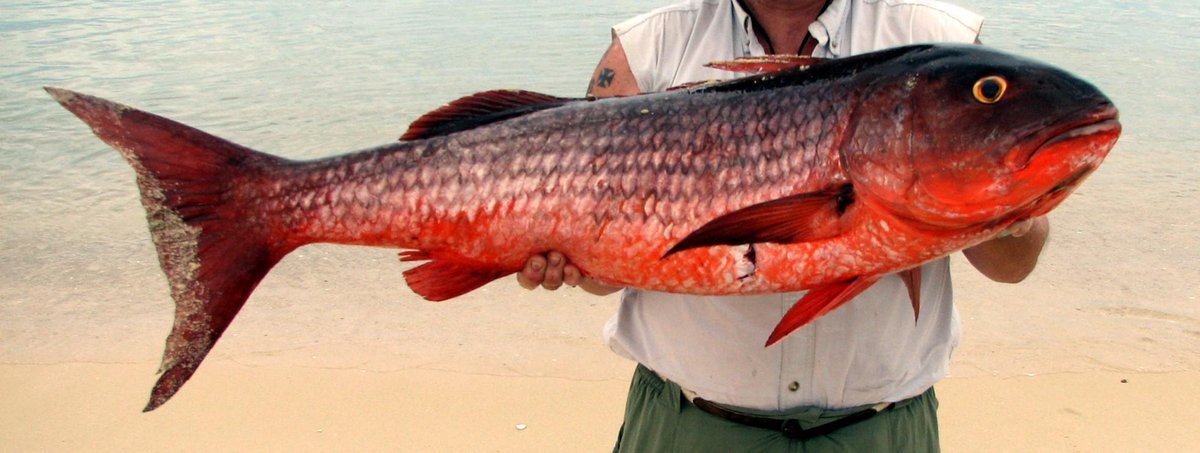
“Mullet Snapper Fishing in Panama: A Premier Challenge for Sport Fishermen
The Mullet Snapper, celebrated for its large size and formidable strength, is a highly valued catch among sport fishermen in Panama. This article explores the art and excitement of Mullet Snapper fishing in this renowned fishing destination.
Ideal Locations and Prime Fishing Season
Inhabiting the Pacific and Caribbean waters of Panama, the Mullet Snapper is most commonly found in coastal regions and around coral reefs. The optimal time for sport fishing this species runs from June to November, aligning with more favorable sea conditions for a successful catch.
Strategies and Techniques for Catching Mullet Snapper
Catching a Mullet Snapper demands skill, patience, and the right equipment. Due to its strength and cunning nature, anglers must use strong and suitable fishing gear. A highly effective method for attracting these fish is live bait fishing, utilizing crabs or shrimp.
Artificial lures like jigs and spoons are also popular, especially when they mimic the natural movement of the Snapper’s prey. Bottom fishing is the most prevalent technique, where bait or lure is strategically placed on the seabed, a typical habitat for the Mullet Snapper. Once the fish bites, it often leads to an exhilarating battle, as Mullet Snappers are known for their robust fight.
Sustainable Fishing Practices
Sustainable fishing practices are crucial for preserving Mullet Snappers and the marine ecosystems they inhabit. Panamanian fishing authorities have set specific regulations to control the daily catch limit per angler. Responsible fishing, including releasing non-consumptive catches and minimizing ecological impact, is essential.
Barracuda – Sphyraena Barracuda
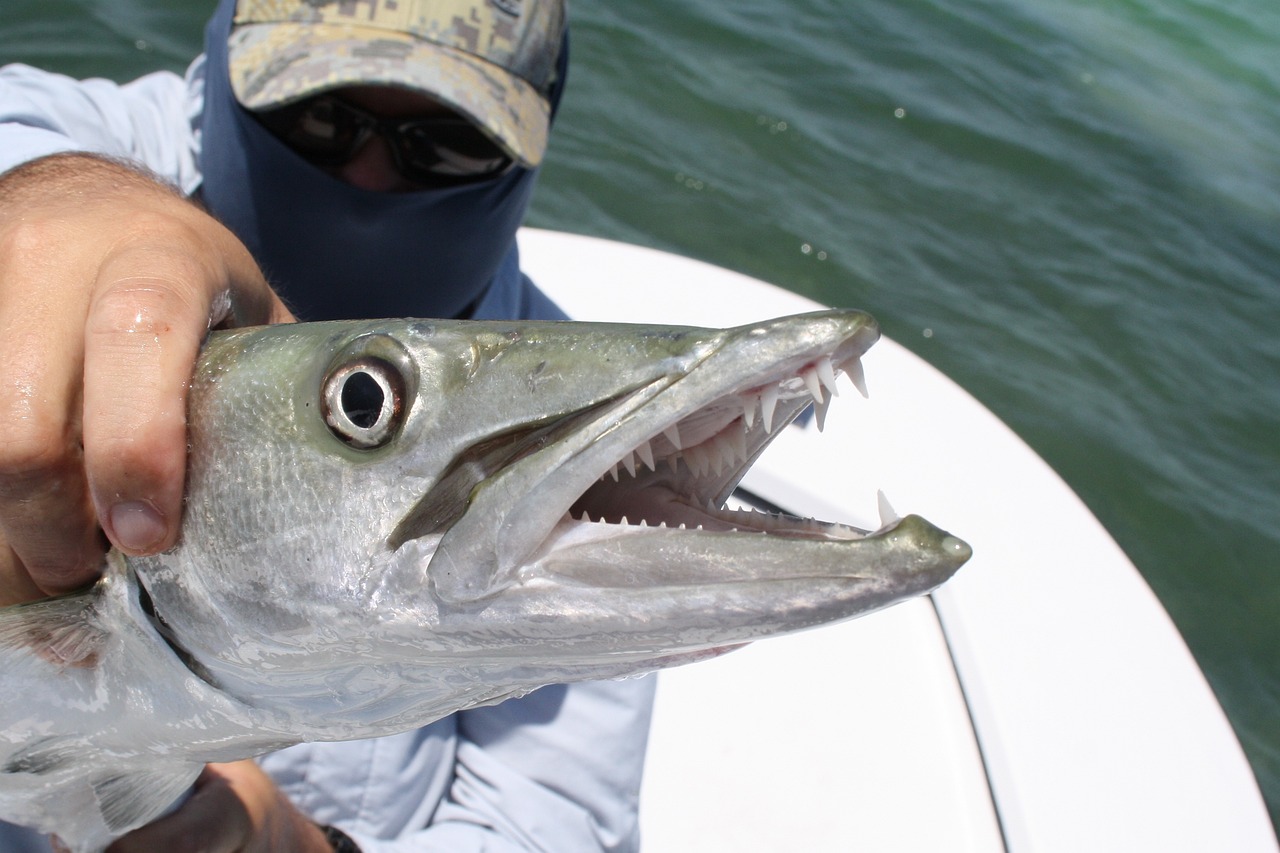
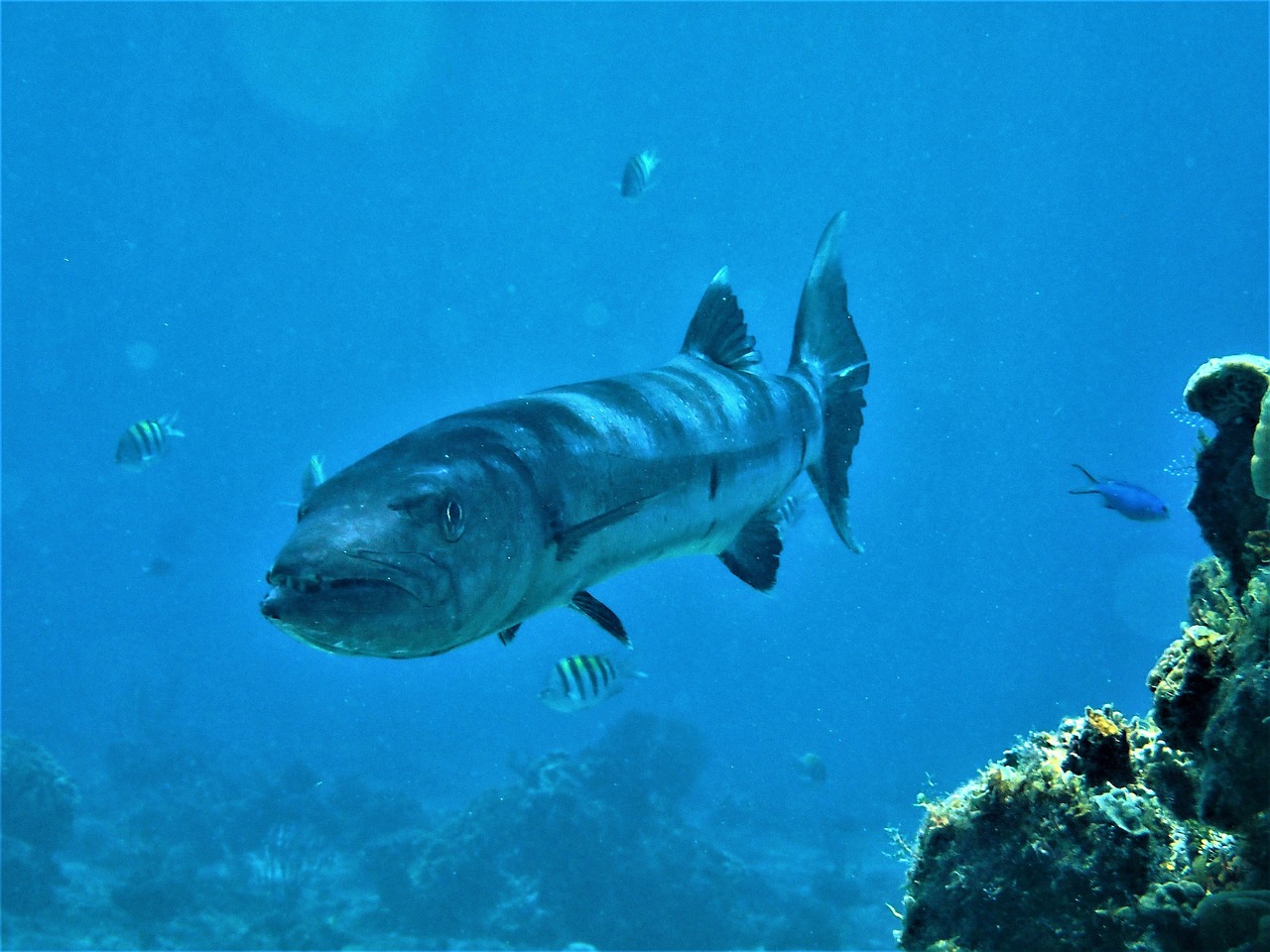
“Sphyraena Barracuda Fishing in Panama: The Thrill of Catching the Caribbean Barracuda
Fishing for Sphyraena Barracuda, a formidable predator in the warm waters of Panama, offers an exhilarating challenge for sport fishermen. This article delves into the world of Barracuda fishing, shedding light on the habits of this captivating fish and the thrill of pursuing it in Panama.
Characteristics of the Sphyraena Barracuda Known as the Caribbean Barracuda, the Sphyraena Barracuda is an elongated, silver-colored fish characterized by its thin, tapering body, large head, and razor-sharp teeth. Capable of growing up to 1.5 meters and weighing over 45 kilos, their diet predominantly consists of small fish and crustaceans.
The Art of Barracuda Fishing in Panama Panama’s Pacific and Caribbean coasts are prime spots for Barracuda fishing, attracting numerous sport fishing enthusiasts. These fish are found in various environments, including shallow waters, open waters, near reefs, bays, and river inlets.
Barracudas are known for their strength and feistiness, presenting a formidable challenge to anglers. Popular fishing methods include using live bait, topwater lures, jigs, and lead lures. Given the Barracuda’s cautious nature, selecting the right lure and employing effective fishing techniques are key to a successful catch.
Optimal Season for Fishing The best time for Barracuda fishing in Panama spans from April to October, coinciding with optimal water conditions for sport fishing. However, Barracuda fishing is a year-round activity in Panama.
Fishing Regulations and Sustainable Practices Sport fishing in Panama is regulated to ensure the sustainability of fish populations. Barracudas have a catch limit of 3 per angler, and they must be at least 60 centimeters in length. Adhering to these regulations is essential for preserving the Barracuda population and maintaining ecological balance.
Bonito (Sarda Sarda)
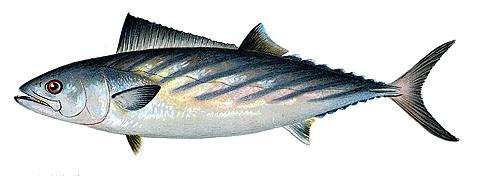
“Bonito Fishing in Panama: An Exhilarating Sport Fishing Experience
In Panama’s diverse aquatic environment, Bonito, a medium-sized fish known for its agility and activity, offers sport fishermen an exciting fishing adventure. This article dives into the thrill of Bonito fishing in Panama, providing insights into the best practices and seasons.
Prime Locations and Ideal Fishing Season Bonito thrive in both the Pacific and Caribbean waters of Panama, with a more prominent presence in the Pacific coastal areas. The prime season for Bonito fishing extends from March to September. During this period, the sea conditions are calmer, making it an ideal time for anglers to pursue this species.
Effective Fishing Techniques Anglers have a wide array of techniques and equipment at their disposal for Bonito fishing. Common methods include using artificial lures like spoons, jigs, and poppers. Live bait fishing with shrimp or small fish is also effective. Choosing the appropriate lure or bait is crucial, depending on the time of year and sea conditions.
Fishing for Bonito is both active and thrilling. Known for their ability to leap out of the water and provide a robust fight, Bonito require sturdy and suitable fishing gear. A high-quality fast-action rod and reel are recommended for a successful catch.
Sustainable Fishing Practices Adhering to sustainable fishing regulations and practices is essential for the conservation of Bonito and the marine ecosystems of Panama. The Panamanian fishing authorities have set daily catch limits to manage the Bonito population responsibly. It is also advised to release fish that won’t be consumed and to utilize fishing methods that minimize ecological impact.
Cherna (Epinephelus Morio)
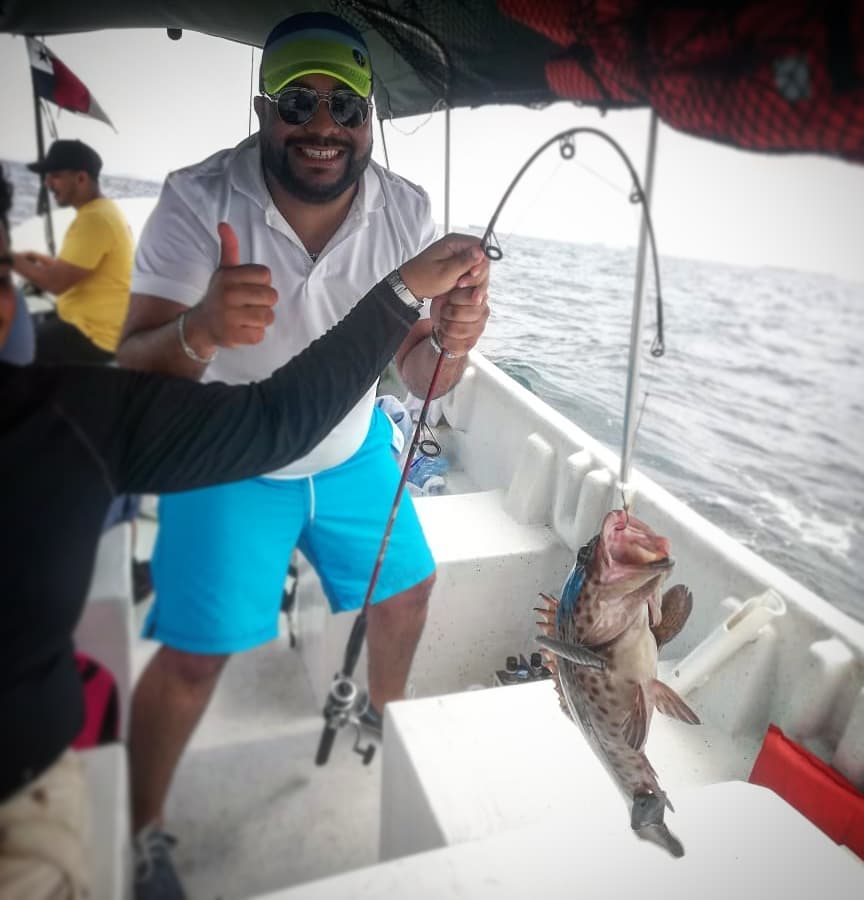
“Grouper Fishing in Panama: A Culinary Delight and Sport Fishing Adventure
In Panama, Grouper fish, known locally as Cherna, stand as a pinnacle of sport fishing, celebrated for their delicious meat and the thrill they offer to anglers. This article explores the rewarding experience of Grouper fishing in Panama’s abundant waters.
Prime Locations and Peak Season Grouper fish predominantly reside in Panama’s Pacific and Caribbean waters, with a higher concentration along the Pacific coast. The optimal season for Grouper fishing in Panama stretches from June to October. During these months, sea conditions are generally calmer, enhancing the fishing experience.
Techniques for Capturing Grouper Anglers in Panama employ various techniques and equipment for Grouper fishing. Common methods include using artificial lures such as jigs and poppers. Live bait fishing, utilizing shrimp or small fish, is also effective. It’s crucial to select the right bait or lure based on the season and current sea conditions.
Grouper fish are known for their size and strength, often resulting in a prolonged and exciting battle. Therefore, using sturdy and suitable fishing equipment, like a heavy-action rod and a high-quality reel, is essential for a successful catch.
Sustainable Fishing Practices Sustainable fishing practices are vital for conserving Grouper populations and their marine habitats. It is crucial to follow the regulations set by Panamanian authorities, including releasing fish not intended for consumption and using fishing methods that minimize ecological impact.
Jack Crevalle (Caranx caninus)
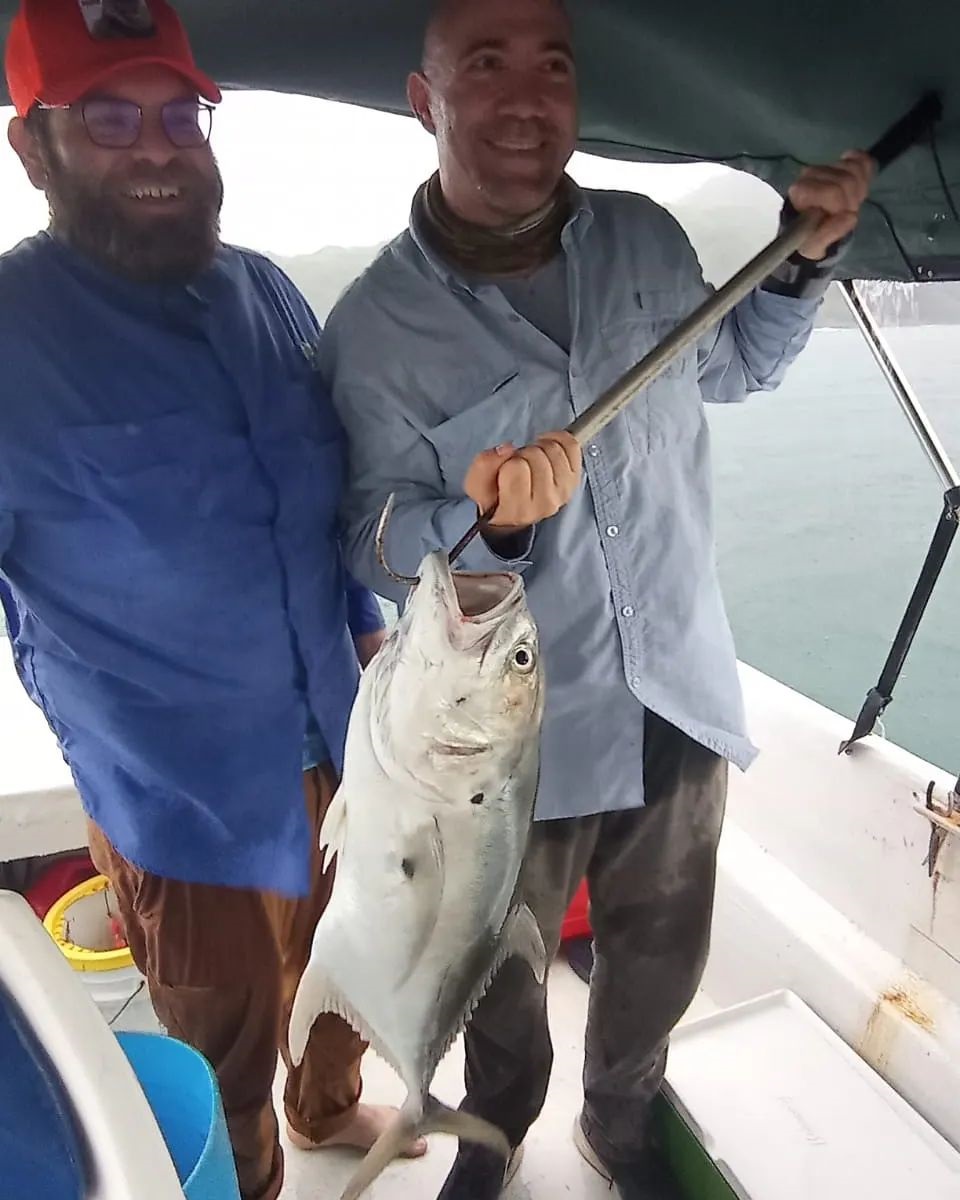
“Seriola Rivoliana Fishing in Panama: A Thrilling Encounter for Sport Fishermen
Panama, with its rich marine biodiversity, is a haven for sport fishermen, offering an array of coveted fish species known for their size and flavor. Among these, Seriola rivoliana, popularly known as Lemon Fish, Horse Mackerel, or Yellowtail, emerges as a favorite in sport fishing circles.
Characteristics of Seriola Rivoliana
Seriola rivoliana is a formidable catch, often reaching up to one meter in length and weighing over 20 kilos. Prized for its size, strength, and delectable flavor, it poses a real challenge for anglers, especially as it dwells in deep-sea waters.
Prime Locations in Panama
In Panama’s Pacific waters, Seriola rivoliana is frequently found along the western coastline, with hotspots like Pedasi, Boca Chica, Isla Parida, and the Dry Islands. These areas are renowned for their abundant Seriola rivoliana populations, providing sport fishermen with excellent opportunities for a successful catch.
Techniques and Regulations for Fishing
Catching Seriola rivoliana demands large, sturdy fishing rods capable of withstanding the fish’s immense strength. Effective lures for attracting this species include poppers, jigs, and spoons. Anglers planning to fish Seriola rivoliana in Panama should be aware of the local fishing regulations and obtain the necessary permits, ensuring a responsible and enjoyable fishing experience.
Broom-Tailed Grouper (Mycteroperca Xenarcha)
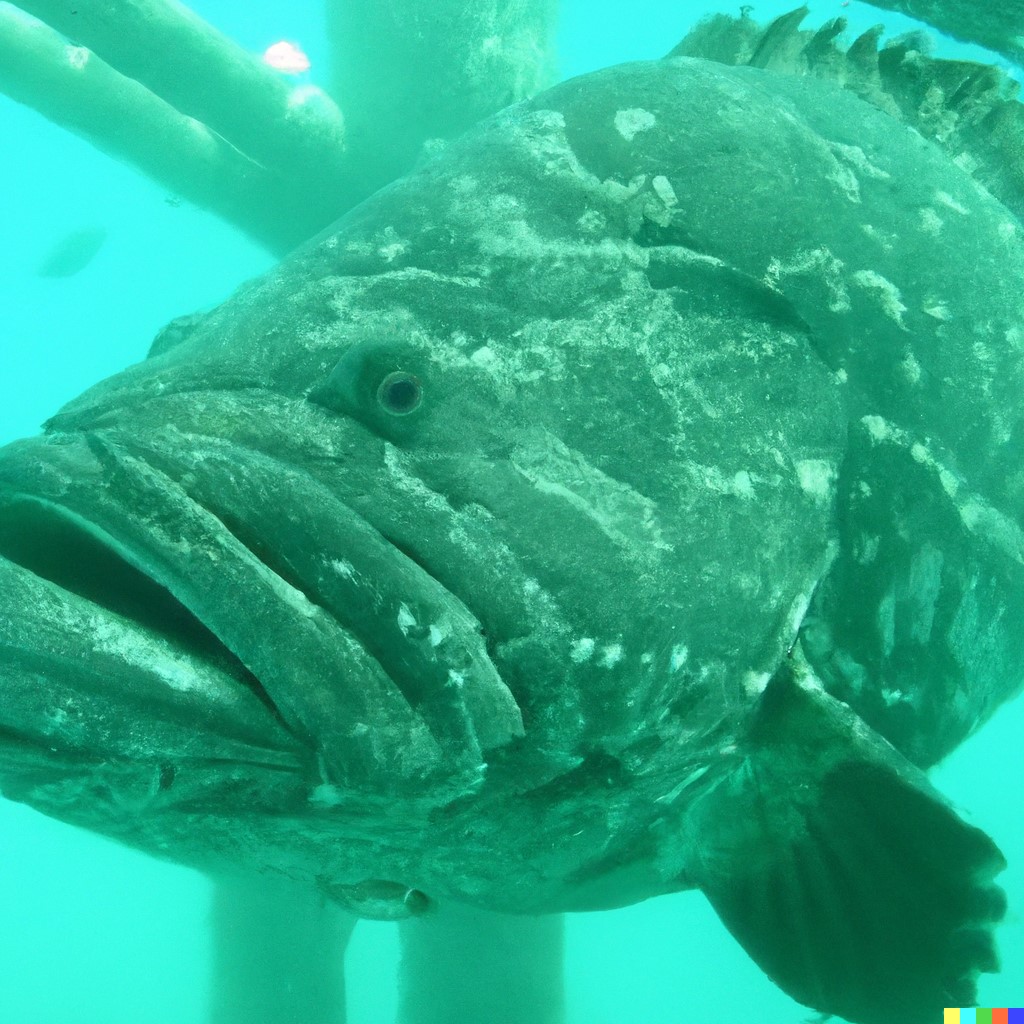
“Broomtail Grouper Fishing in Panama: A Challenge for Enthusiasts
In Panama, the Broomtail Grouper, or White Grouper, stands as a highly coveted species among sport fishermen, known for its impressive size and remarkable fighting ability. This article delves into the exciting world of Broomtail Grouper fishing in Panama’s diverse aquatic environments.
Prime Locations and Optimal Fishing Season The Broomtail Grouper inhabits Panama’s coastal waters, found in both the Pacific and the Caribbean. It thrives in rocky areas and coral reefs, presenting a rewarding challenge for anglers. The best time for fishing this species is from July to November, coinciding with warmer waters and increased fish activity.
Effective Fishing Techniques Sport fishing for Broomtail Grouper in Panama encompasses a range of techniques and equipment. Natural bait fishing, using squid or live fish, is a popular and effective method. Artificial lures, such as jigs and poppers that mimic the grouper’s natural prey, can also be successful. It’s crucial to select the appropriate technique and gear based on seasonal sea conditions.
Anglers can expect a vigorous and enduring battle when hooking a Broomtail Grouper, due to its large size and strength. Hence, using robust fishing gear, including heavy-action rods and high-quality reels, is essential for a successful catch.
Sustainable Fishing Practices Sustainable fishing practices are strongly recommended to protect the Broomtail Grouper and Panama’s marine ecosystems. Anglers are encouraged to release fish not intended for consumption and to employ fishing techniques that minimize ecological impact, ensuring the preservation of this magnificent species for future generations.
Barred Snapper (Lutjanus Guttatus)
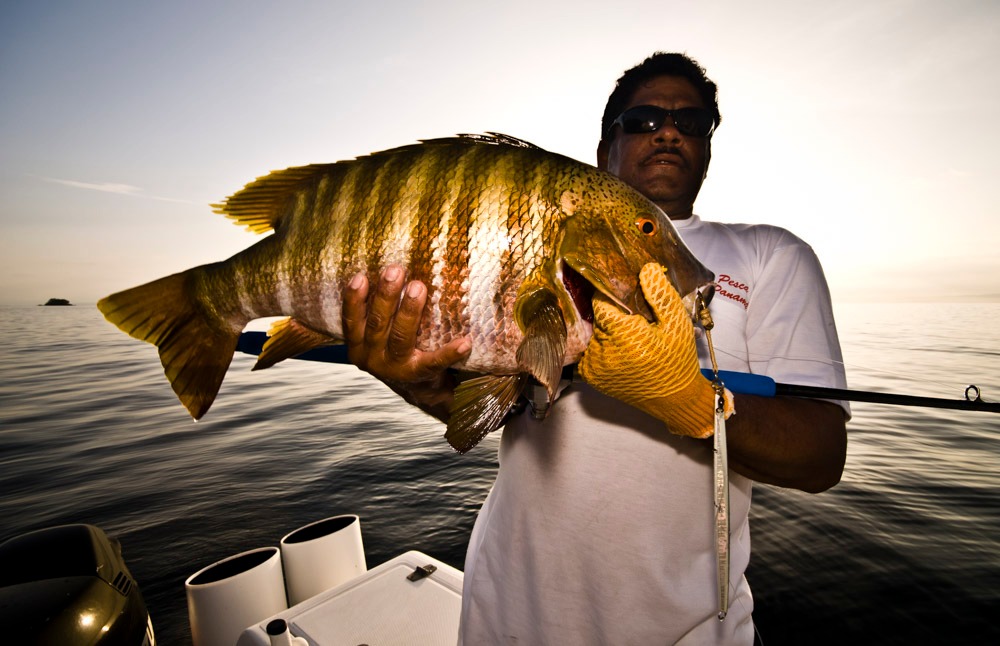
“Barred Snapper Fishing in Panama: A Delight for Sport Fishermen
In Panama, the Barred Snapper, Lutjanus Guttatus, is a sought-after species among sport fishermen, revered for its delectable meat and spirited fight. This article delves into the thrilling world of Barred Snapper fishing, a favorite pursuit for anglers in Panama’s rich marine environment.
Prime Locations and Ideal Fishing Season The Barred Snapper is abundantly found in Panama’s coastal waters, thriving both in the Pacific and the Caribbean. Favored spots include rocky areas and coral reefs, habitats conducive to this species. The optimal fishing season for Barred Snapper in Panama spans from May to September, coinciding with warmer waters and increased fish activity.
Effective Fishing Techniques Anglers employ various techniques and equipment to catch Barred Snapper. Natural bait fishing, using live shrimp or crabs, is a popular and effective method. Alternatively, artificial lures like jigs and poppers can also yield successful catches by mimicking the fish’s natural prey. Selecting the appropriate technique and gear is crucial, considering the seasonal sea conditions.
Known for its strength and cunning, the Barred Snapper provides a vigorous and prolonged battle, making for an exhilarating fishing experience. Anglers are advised to use robust fishing gear, including heavy-action rods and high-quality reels, to handle the challenge effectively.
Sustainable Fishing Practices Sustainable fishing practices are highly encouraged to conserve Barred Snapper populations and protect Panama’s marine ecosystems. Responsible fishing includes releasing fish not intended for consumption and employing techniques that minimize environmental impact.
If you are looking for a unique sport fishing experience in Panama, we offer you a selection of packages designed to maximize your adventure and satisfy all your expectations. From beginners to experienced anglers, we have options for everyone: